New Guinea: Warplanes of the Second World War preserved
Papua, New Guinea National Museum
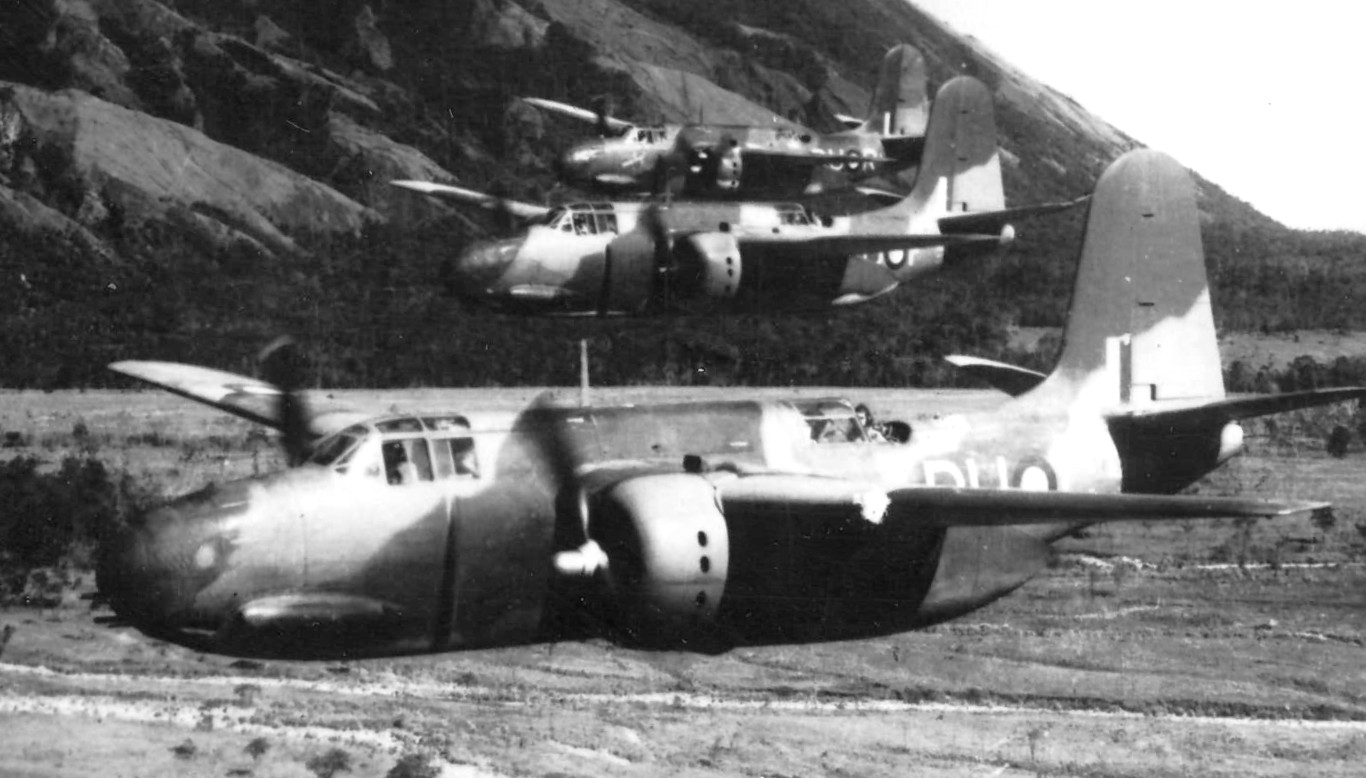
(Australian War Memorial Photo)
Douglas A20 Havocs of No. 22 Squadron over New Guinea, c. 1942–43.
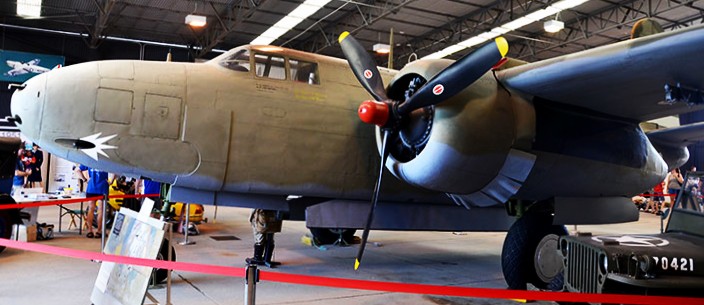
(RAAF Amberley Aviation Heritage Centre Collection Photo)
Douglas A-20G-20-DO Havoc (Serial No. 42-86786), coded F, "The Hell'N Pelican II".
Built by Douglas Aircraft Company at Long Beach, California. On 1 Sep 1943 delivered to the U.S. Army Air Force (USAAF) as A-20G-20-DO Havoc (Serial No. 42-86786). She was disassembled and shipped overseas to Australia and re-assembled in Melbourne. During November 1943 or December 1943 she was flown northward to Port Moresby. 42-86786 was assigned to the 5th Air Force (5th AF), 3rd Bombardment Group (3rd BG), 90th Bombardment Squadron (90th BS) at 17 Mile Drome near Port Moresby. Nicknamed "Louisiana Belle" with the a shark tooth motif on the nose. During February 1944, she was assigned to the 312th Bombardment Group (312th BG) "Roarin' 20's", 388th Bombardment Squadron (388th BS). Assigned to pilot Lt. William Mathison who renamed it "Gloria", but the plane required repairs and servicing. On 21 March 1944 she was flown to Gusap Airfield. Next, assigned to pilot 2nd Lt. Charles Davidson. Nicknamed "The Hell'N Pelican II" with the nose art of a pelican with wings spread with a bomb under the right wing atop a light blue outline. Previously, his first aircraft P-40N "The Hell'N Pelican". Assigned to crew chief "Fudgie" Figuerido, he chose tail letter "F" as the first letter of his surname. The rear fuselage had the squadron motif, a playing card suit heart in white.
On 29 March 1944 she was flown on her first combat mission, a low level strike against Bunabun Harbour. On 16 April 1944, "The Hell'N Pelican" took off from Gusap Airfield piloted by 2nd Lt. Charles Davidson with gunner Sgt John L. McKenna on a low level strike against Hollandia. On the return flight, the formation ran into bad weather and ran low on fuel to the west of Madang. Davidson offered McKenna the chance to bail out, but he responded "Lieutenant what are you going to do?" Davidson said "I'm going in with the ship." and McKenna said in reply "Let's go." At 5:15pm this A-20 force-landed in kunai grass near Amaimon and skidded roughly 300 meters before it came to a stop. During the landing the propellers were bent backward and the leading edge of the left wing was damaged when it impacted small trees. Afterwards, the mission was dubbed "Black Sunday" and was the largest operational loss suffered by the U.S. Army Air Force (USAAF) during the Second World War.
Both crew survived the landing unhurt and spent the night with the plane. Although both were alive, they landed behind enemy lines and their families were notified they were Missing In Action (MIA). On the morning of 17 April 1944, the A-20 and crew were spotted by a Republic P-47D Thunderbolt, which dropped them a message, but it landed too far away to retrieve. Later, a flight of six A-20s flew overhead and dropped notes, but again they were unable to be found. Next, a single A-20 dropped a note that read "Food on the way", plus a radio, rations, lifeboat and first aid kit. Everything was recovered except for the radio. Later at 4:00pm, a Stinson L-5 from the 25th Liaison Squadron "Guinea Short Lines" arrived and photographed the A-20 at low level. The plane also dropped a note with a map indicating their location and instructing them to to walk towards the crash site of A-20G "Lady Constance" (Serial No. 43-9628). In the late afternoon, the pair started walking southward with improvised backpacks made from their parachutes. Overnight while camping, a rain storm flooded the area, fouled their weapons and ruined their compass.On the morning of 18 April 1944, a Japanese Army patrol of ten soldiers passed nearby. After waiting for them to pass, they returned to the A-20, and camped at the edge of the jungle near the plane.
On 19 April 1944 a pair of Japanese planes strafed the wreck once and departed. That same day, they were dropped another note and instructed to clear a runway in the kunai grass for a L-5 to land to rescue them. For the rest of the day, they worked in shifts to cut kunai and clear vegetation. On 20 April 1944 again, a pair of Japanese planes strafed the plane. To help clear the kunai grass, an L-5 dropped a incendiary bomb, but it failed to ignite and rains put out fires they tried to start. On 22 April 1944 a P-40 Warhawk dropped an incendiary, but the ground was too wet to burn. On 22 April 1944 after the Australian Army captured Madang, a note was dropped instructing them to walk to the Gogol River roughly 1.5km away. Before departing, Davidson removed the Douglas Aircraft Company logo from the control yoke. Walking in dense vegetation, it took the pair days to reach the Gogol River and they deployed their life raft to float downstream and passed many crocodiles. Overhead, their progress was monitored by an L-5. On 1 May 1944 they spotted the HMAS Matafele and were taken aboard and transported to Madang Airfield. An L-5 arrived to transport both to Gusap Airfield, returning both to duty. Davidson had grown a beard after two weeks in the jungle.
Afterwards, Davidson was assigned another A-20 which he did not give a nickname. McKenna died on 11 October 1944 as a passenger aboard North American B-25D "Five Minutes To Midnight" (Serial No. 41-30525) in New Guinea and remains listed as Missing In Action (MIA). The intact A-20 was clearly visible from above. For months, it was sometimes used as a navigation reference point by pilots from the 388th Bombardment Squadron (388th BS) flying missions past the location.Later in 1944, the aircraft was visited by a patrol officer (kiap) from Australia New Guinea Administrative Unit (ANGAU) who noted the markings on the wings and fuselage were still visible including tail letter "F" and "286786" (Serial No. 42-86786), red spinners and on the left side of the nose was "Louisiana Belle" (the previous nickname) with the names "pilot C. H. Davidson" and "crew chief S/Sgt Figuerido". On the right side of the nose was "Gloria" and "pilot Lt. W. L. Mathison". Inside the aircraft the radios appeared to be in good condition and all the machine guns were in good order. Nearby were roughly a dozen containers for message drops including one with the note still inside and empty food tins. The local people reported the air crew had been rescued.
By the 1950, vegetation had largely overgrown the plane. During the 1960's, Chinese youths from Madang removed several of the nose machine guns, one of the top turrets machine guns and cockpit instruments. The nose art faded off, revealing the previous markings of "Gloria" and "Louisiana Belle" and the shark tooth markings.During August 1979, Michael Claringbould learned about the wreck from a kiap (patrol officer) at Bogia. Trekking to Amaimon with two locals, Claringbould walked to the crash site and noted the serial number. Writing to the USAF Historical Section at Maxwell AFB, the details of the crash were confirmed. With the help of Russell Sturzebecker, he was put into contact with former pilot, Charles Davidson, who he met in 1985 at the 312th Bombardment Group (312th BG) association reunion in Niagara Falls, New York.
The Royal Australian Air Force (RAAF) and Royal Australian Navy (RAN) planned a training exercise "Operation Venture One" to salvage an A-20 wreck as a training exercise, using a CH-47 Chinook from No. 12 Squadron with assistance from Michael Claringbould. Assembling at Amberley Airfield on 11 September 1984 the team departed for PNG. 1 Air Depot (1 AD) C. O. Tom Kelly was tasked with disassembly of the wreck. Departing on 14 Sep, the team flew to Daru Airfield then to Jackson Airport. On 17 Sep, the CH-47 took off with passengers S/L Rick Lunburg, Michael Claringbould and Bruce Hoy, curator of modern history PNG Museum to relocate the crash site from the air. On 18 Sep 1984 five team members were landed to disassemble the aircraft. When it proved too heavy to lift, the engines were removed. On 1 Oct, the fuselage was flown to Madang Airport and on a second trip returned to pickup the ground crew and engines. Next, loaded aboard the HMAS Tarakan and transported to Brisbane arriving in November 1984. Afterwards, moved to Amberley Airfield for storage and restoration.
This aircraft was restored by the RAAF at Amberley Restoration Facility by a team led by Denis Doggett between 1984-1996. The restoration also used parts salvaged from other A-20G Havoc wrecks salvaged from Papua New Guinea. The aircraft was meticulously restored to static condition.During 1985, at the reunion of 312th Bombardment Group (312th BG) veterans guest speaker Michael Claringbould presented former pilot Davidson the original flight yoke from the aircraft as a gift. On 12 Sep 1996, during a ceremony at Amberley Airfield, the fully restored to static display Havoc was officially handed back to the government of Papua New Guinea (PNG). In attendance was former pilot Charles Davidson, his wife Thelma Davidson and Michael Claringbould. The restored A-20 had been stored in a hangar at Amberley Airfield since 1996, pending the completion of suitable display facilities at the National Museum & Art Gallery (NMAG) in Port Moresby. It was later displayed at the RAAF Amberley Aviation Heritage Centre by appointment, open hanger days or other special occasions.
In late May 2025, the A-20 was disassembled at the RAAF Amberley Aviation Heritage Centre with the tail and outer wings removed in preparation for return to Papua New Guinea for display in the newly built Aviation Heritage Hangar. The bomber was transported by truck from Amberley Airfield northward to Townsville. On 5 June 2025 the aircraft was loaded aboard ADV Reliant for the three day voyage to Port Moresby. (Pacific Wrecks)
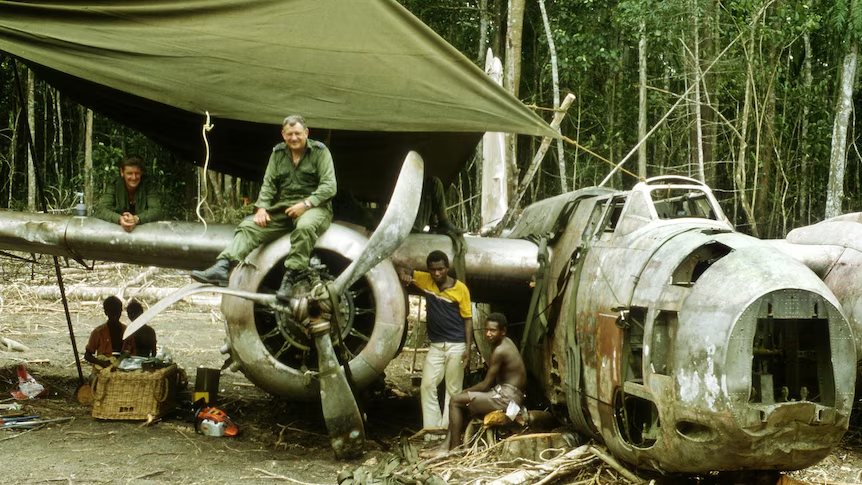
(Michael Claringbould Photo)
RAAF Wing Commander Tom Kelly sits upon the engine of the Douglas A-20G Havoc bomber " Hell'n Pelican II" when it was salvaged in October 1984.
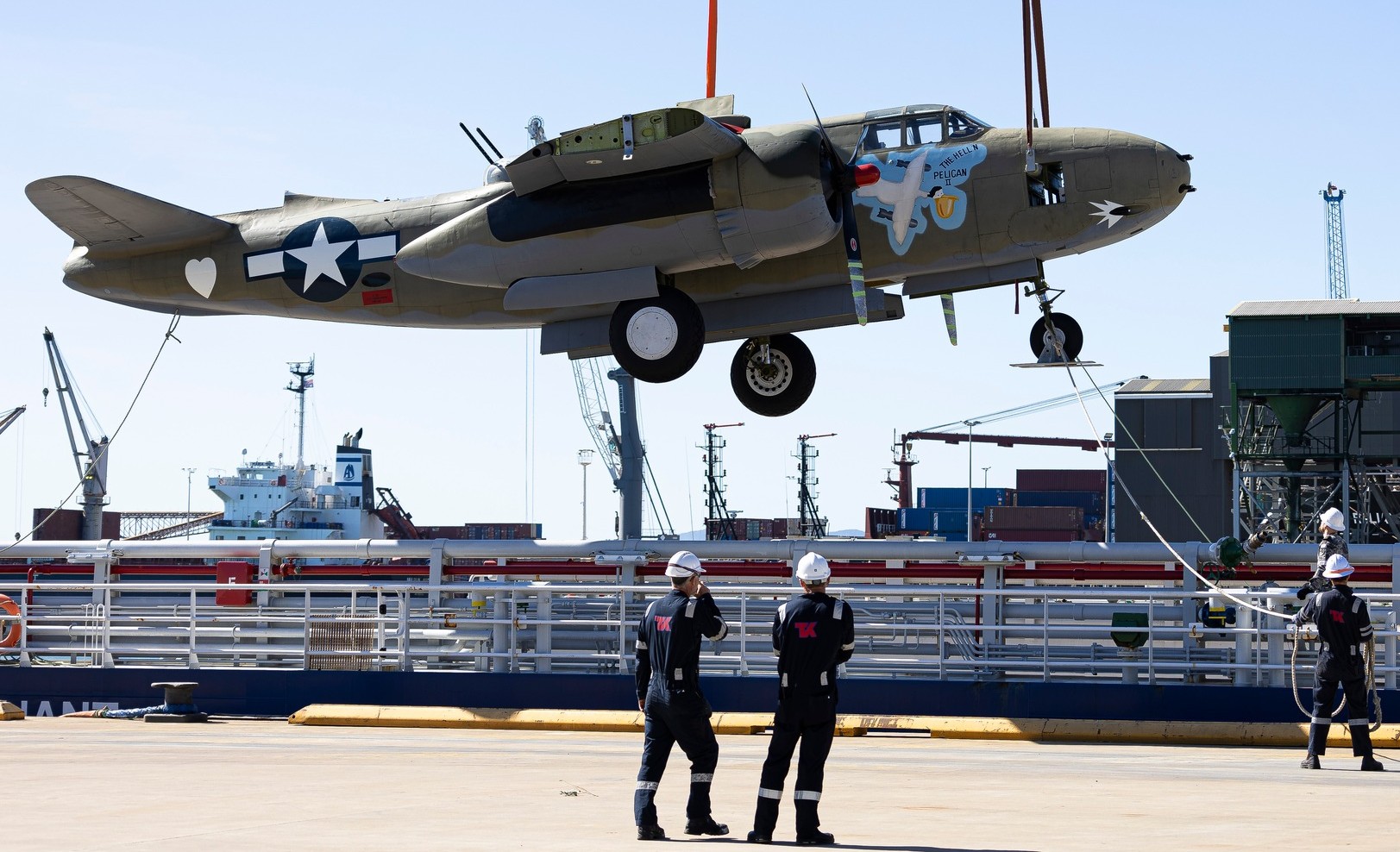
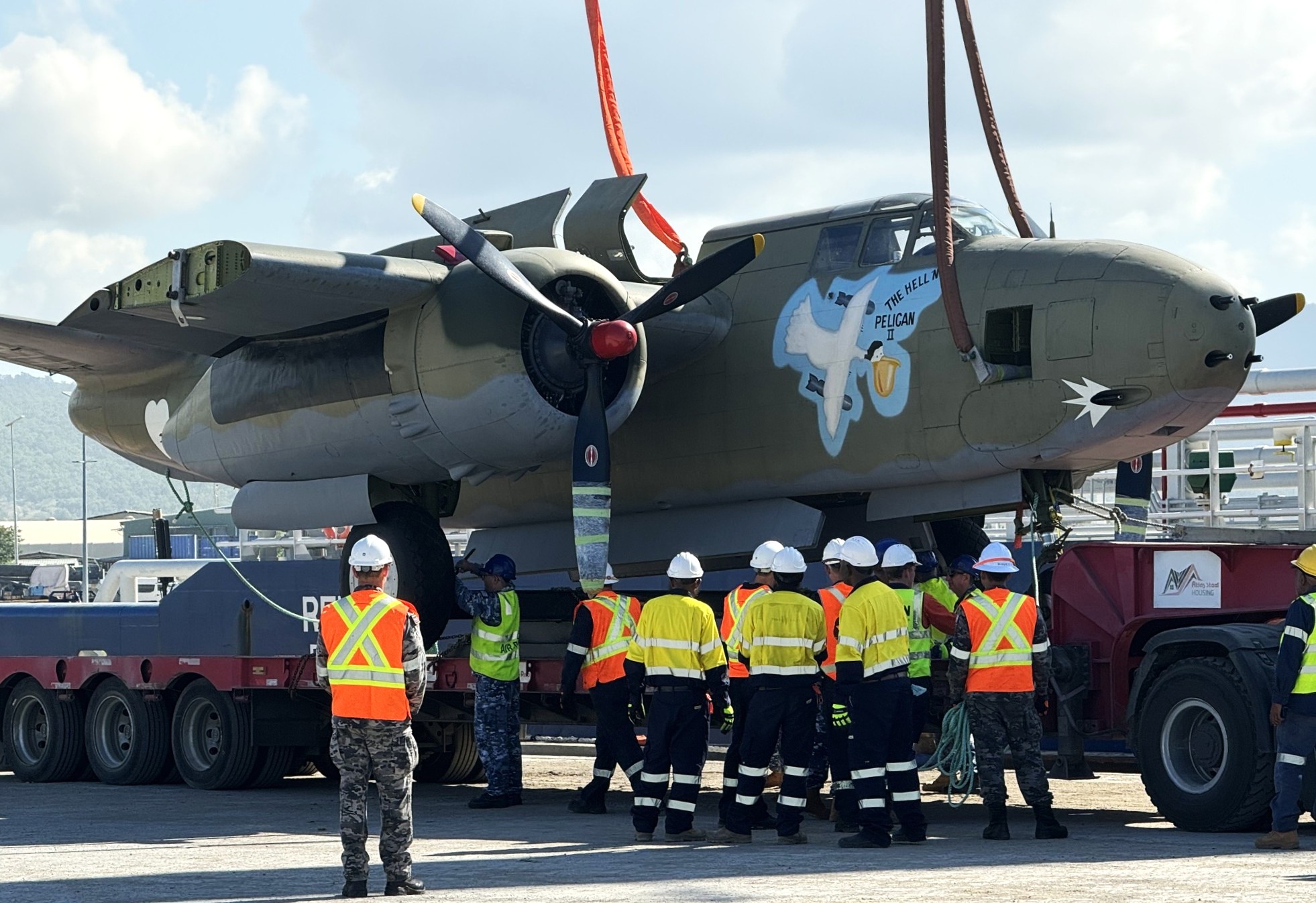
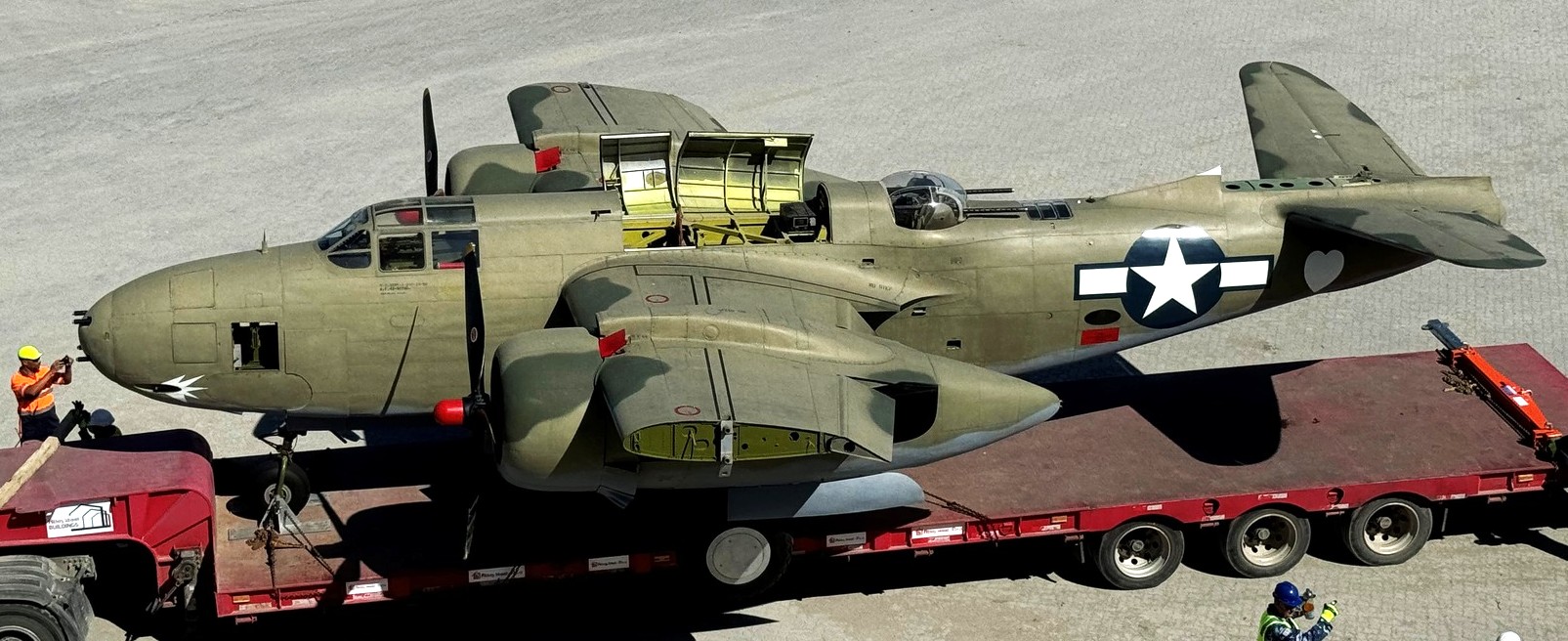
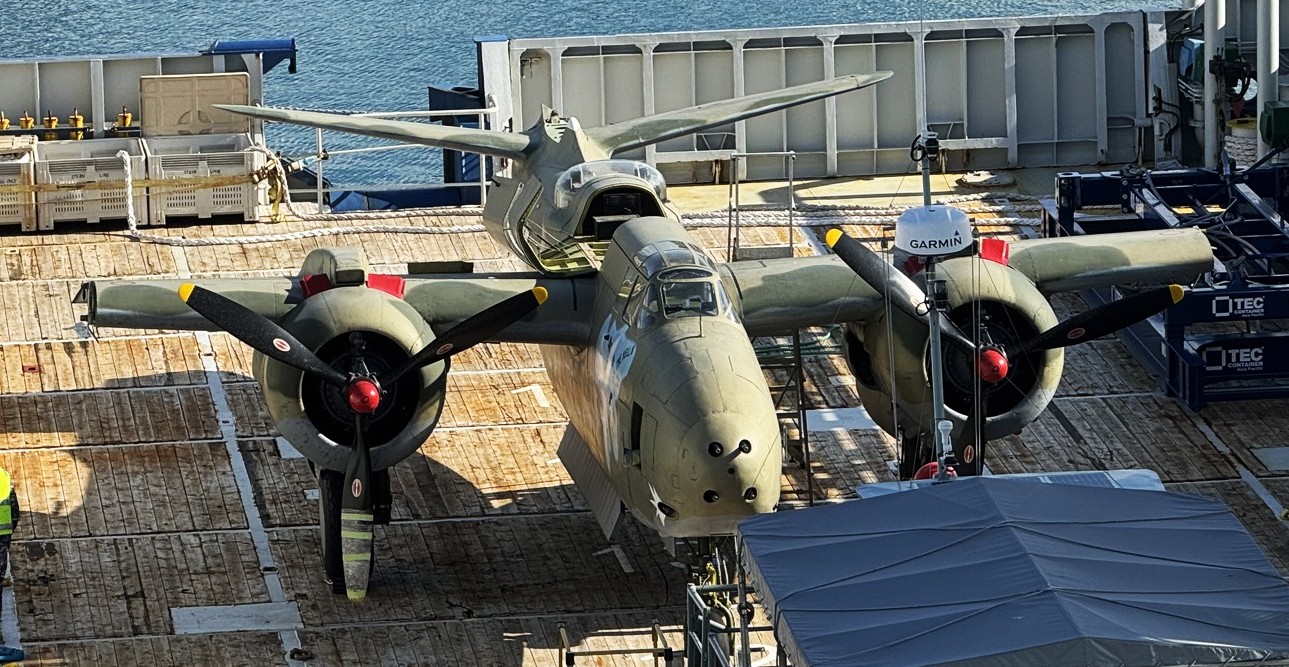
(Australian High Commission Photos)
Douglas A-20G-20-DO Havoc (Serial No. 42-86786), coded F, "The Hell'N Pelican II", being loaded for shipment to Papua, New Guinea, 11 June 2025.





